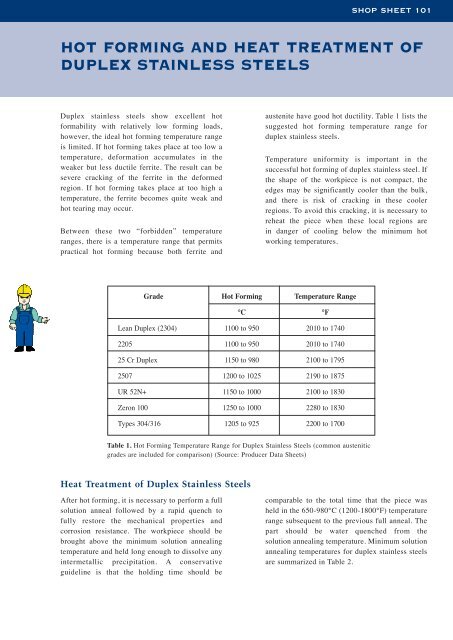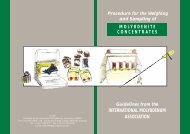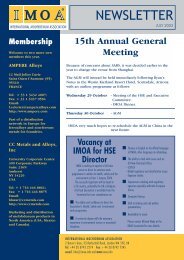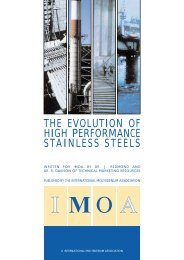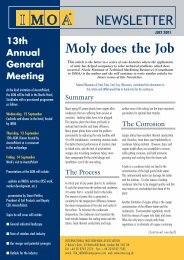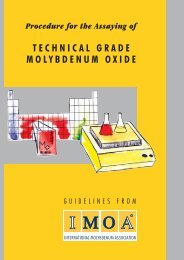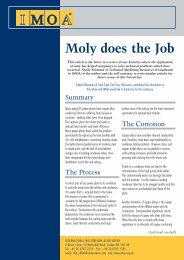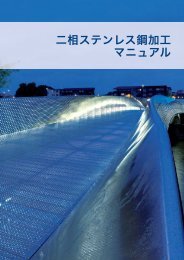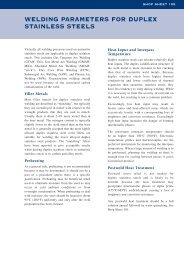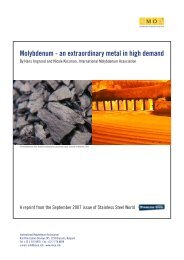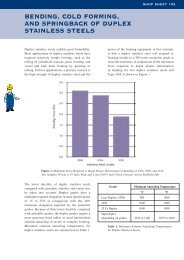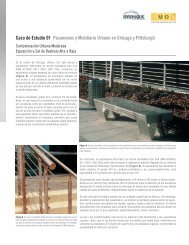101: Hot forming and heat treatment of duplex stainless steels - IMOA
101: Hot forming and heat treatment of duplex stainless steels - IMOA
101: Hot forming and heat treatment of duplex stainless steels - IMOA
You also want an ePaper? Increase the reach of your titles
YUMPU automatically turns print PDFs into web optimized ePapers that Google loves.
SHOP SHEET <strong>101</strong><br />
HOT FORMING AND HEAT TREATMENT OF<br />
DUPLEX STAINLESS STEELS<br />
Duplex <strong>stainless</strong> <strong>steels</strong> show excellent hot<br />
formability with relatively low <strong>forming</strong> loads,<br />
however, the ideal hot <strong>forming</strong> temperature range<br />
is limited. If hot <strong>forming</strong> takes place at too low a<br />
temperature, deformation accumulates in the<br />
weaker but less ductile ferrite. The result can be<br />
severe cracking <strong>of</strong> the ferrite in the deformed<br />
region. If hot <strong>forming</strong> takes place at too high a<br />
temperature, the ferrite becomes quite weak <strong>and</strong><br />
hot tearing may occur.<br />
Between these two “forbidden” temperature<br />
ranges, there is a temperature range that permits<br />
practical hot <strong>forming</strong> because both ferrite <strong>and</strong><br />
austenite have good hot ductility. Table 1 lists the<br />
suggested hot <strong>forming</strong> temperature range for<br />
<strong>duplex</strong> <strong>stainless</strong> <strong>steels</strong>.<br />
Temperature uniformity is important in the<br />
successful hot <strong>forming</strong> <strong>of</strong> <strong>duplex</strong> <strong>stainless</strong> steel. If<br />
the shape <strong>of</strong> the workpiece is not compact, the<br />
edges may be significantly cooler than the bulk,<br />
<strong>and</strong> there is risk <strong>of</strong> cracking in these cooler<br />
regions. To avoid this cracking, it is necessary to<br />
re<strong>heat</strong> the piece when these local regions are<br />
in danger <strong>of</strong> cooling below the minimum hot<br />
working temperatures.<br />
Grade <strong>Hot</strong> Forming Temperature Range<br />
°C °F<br />
Lean Duplex (2304) 1100 to 950 2010 to 1740<br />
2205 1100 to 950 2010 to 1740<br />
25 Cr Duplex 1150 to 980 2100 to 1795<br />
2507 1200 to 1025 2190 to 1875<br />
UR 52N+ 1150 to 1000 2100 to 1830<br />
Zeron 100 1250 to 1000 2280 to 1830<br />
Types 304/316 1205 to 925 2200 to 1700<br />
Table 1. <strong>Hot</strong> Forming Temperature Range for Duplex Stainless Steels (common austenitic<br />
grades are included for comparison) (Source: Producer Data Sheets)<br />
Heat Treatment <strong>of</strong> Duplex Stainless Steels<br />
After hot <strong>forming</strong>, it is necessary to perform a full<br />
solution anneal followed by a rapid quench to<br />
fully restore the mechanical properties <strong>and</strong><br />
corrosion resistance. The workpiece should be<br />
brought above the minimum solution annealing<br />
temperature <strong>and</strong> held long enough to dissolve any<br />
intermetallic precipitation. A conservative<br />
guideline is that the holding time should be<br />
comparable to the total time that the piece was<br />
held in the 650-980°C (1200-1800°F) temperature<br />
range subsequent to the previous full anneal. The<br />
part should be water quenched from the<br />
solution annealing temperature. Minimum solution<br />
annealing temperatures for <strong>duplex</strong> <strong>stainless</strong> <strong>steels</strong><br />
are summarized in Table 2.
SHOP SHEET <strong>101</strong><br />
Grade<br />
Minimum Annealing Temperature<br />
°C °F<br />
Lean Duplex (2304) 980 1800<br />
2205 1040 1900<br />
25 Cr Duplex 1040 1900<br />
Super<strong>duplex</strong><br />
(depending on grade) 1025 to 1100 1875 to 2010<br />
Table 2. Minimum Solution Annealing Temperatures for Duplex Stainless Steels<br />
(Source: Producer Data Sheets <strong>and</strong> ASTM A 480)<br />
At solution annealing temperatures, <strong>duplex</strong><br />
<strong>stainless</strong> <strong>steels</strong> are quite s<strong>of</strong>t <strong>and</strong> warping <strong>and</strong><br />
distortion are likely if the work piece is not<br />
adequately supported. This can be a significant<br />
problem in tubular products, especially those with<br />
large diameters <strong>and</strong> thin walls. Re-<strong>forming</strong> or<br />
straightening warped <strong>duplex</strong> products is more<br />
difficult than austenitic <strong>stainless</strong> <strong>steels</strong> because <strong>of</strong><br />
the high ambient temperature strength <strong>of</strong> <strong>duplex</strong><br />
<strong>stainless</strong> <strong>steels</strong>. Attempts to minimize this<br />
distortion by short annealing times, slow <strong>heat</strong>ing<br />
into the annealing temperature range, or use <strong>of</strong> a<br />
lower than recommended annealing temperature,<br />
may not dissolve intermetallic phases or may<br />
actually cause the formation <strong>of</strong> additional<br />
amounts <strong>of</strong> intermetallic phases. This will lower<br />
corrosion resistance <strong>and</strong> reduce toughness.<br />
The use <strong>of</strong> stress relief <strong>treatment</strong>s to reduce the<br />
cold work <strong>of</strong> <strong>forming</strong> or straightening operations<br />
is not advisable. The <strong>duplex</strong> <strong>stainless</strong> <strong>steels</strong><br />
inherently have very good chloride stress<br />
corrosion cracking resistance <strong>and</strong> this can be only<br />
marginally improved by reducing residual cold<br />
work. There is no satisfactory temperature below<br />
the solution annealing temperature at which stress<br />
relief can be employed without the danger <strong>of</strong><br />
formation <strong>of</strong> intermetallic phases which will<br />
lower corrosion resistance <strong>and</strong> reduce toughness.<br />
Excerpted from “Practical Guidelines for the<br />
Fabrication <strong>of</strong> Duplex Stainless Steels.”<br />
UR 52N+ is a trademark <strong>of</strong> Creusot-Loire Industrie.<br />
Zeron 100 is a trademark <strong>of</strong> Weir Materials.<br />
©1999 International Molybdenum Association<br />
Printed by BSC Print Ltd, BSC House, 48 Weir Road, London SW19 8UG.<br />
<strong>IMOA</strong>-11


